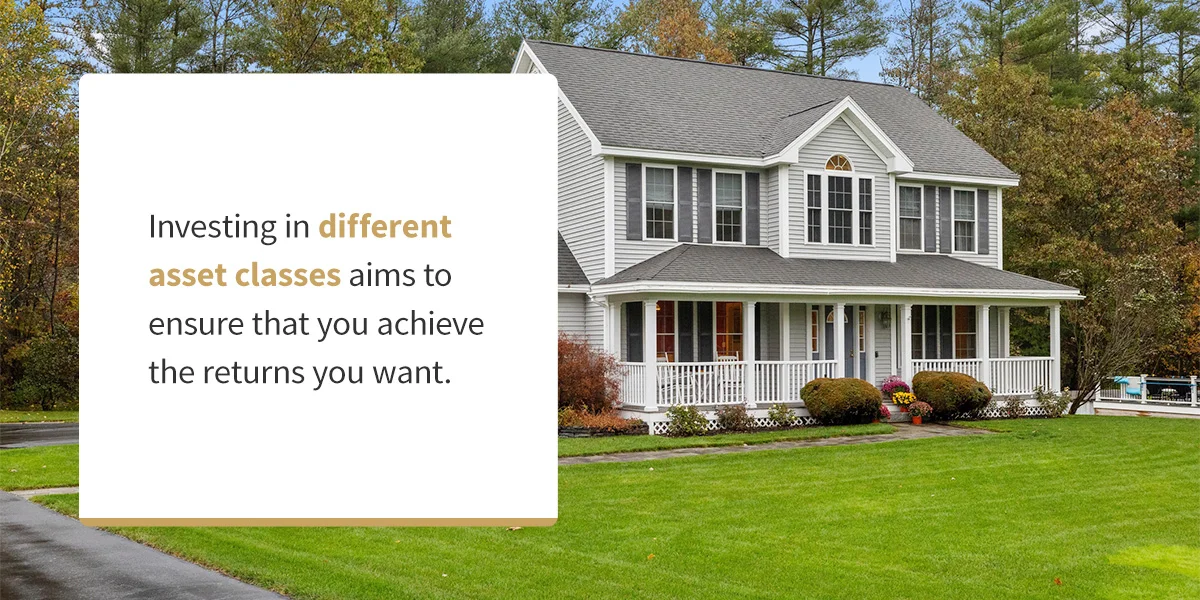When it comes to building an investment portfolio, one thing’s certain: The market may be volatile, but a diversified portfolio is generally considered a smart strategy. Proper diversification offers the risk protection you need to sleep soundly at night, even in unpredictable times.
But what does a truly smart investment portfolio look like, and why is it important to have one? Savvy investors know that balancing risk and reward helps reduce an investment portfolio’s volatility over time. One way to do this is by spreading your portfolio across several asset classes.
Here are eight questions every investor needs to ask about diversification. Before making significant investment decisions, it’s wise to consult with a financial expert or accountant.
1. What’s My Risk Tolerance?
We started with this question because diversification is all about mitigating risk. Of course, some risk is inherent to investing.
But diversification can hedge against unsystematic risk, aka stock market volatility. Diversification spreads your investments across asset classes. If one asset class crashes — say, equities — your risk is reduced because you’ve also invested in other assets, such as bonds or real estate, that may still be going strong.
Start by determining how much volatility you’re comfortable with. Generally, those with lower risk tolerance invest in less volatile assets with a lower potential for return and lower risk of loss. Those with higher risk tolerance invest in more volatile assets with a higher potential for return but a greater risk of loss.
Your financial goals will help you determine how much risk you’re willing to take on. You may want to save for retirement, invest in your children’s education or purchase a home. Once you know what you’re working toward, you can determine the return you need to achieve your goal.
The place you’re at in life will also determine your risk appetite. Say you’re saving up for retirement. If you are fairly young and far off from retiring, you have more time to recover from market losses than someone nearing retirement. Ultimately, your risk tolerance is determined by how comfortable you are with taking on risk. The more comfortable you are with risk, the less likely you will be risk-averse in investing.
The risk tolerance spectrum spans from conservative to aggressive and looks like the following:
- Conservative: You prefer to protect your capital than risk it for potential investment gains.
- Moderately conservative: While you want to protect your capital, you’re willing to take on small risk for investment gains.
- Moderate: You take a balanced approach to risk and reward.
- Moderately aggressive: You’re willing to take on more risk for long-term investment returns.
- Aggressive: Your main goal is to maximize returns, which means you’ll tolerate a lot of volatility along the way.
2. What’s My Risk-Adjusted Rate of Return?
Of course, as an investor, you want to get the highest returns at the level of risk you’re comfortable with. Calculate the risk-adjusted return on investment to map out what this means.
This metric helps you determine the potential return you may receive at a certain level of risk. The risk is then compared to an investment that carries virtually no risk — such as United States Treasury securities. There are various methods to calculate your rate of return, and depending on the one you use, it will be expressed as a number or rating. Your goal? To maximize return potential at whichever risk level you choose.
The risk-adjusted rate of return calculates the profit your investment has made relative to the amount of risk you took on over a period. For example, if two investments give the same return over a period, the one with the lower risk will have the better risk-adjusted rate of return.
There are various risk measurements that you can use, including:
- The Sharpe ratio: This measures the profit on an investment that exceeds the risk-free rate per unit of standard deviation.
- Alpha: This compares an investment’s return to a benchmark’s return.
- Beta: A comparison between an investment’s return and the overall market.
- R-squared: This is a percentage of an investment’s performance that an index’s performance can explain.
- Standard deviation: How volatile an investment is in relation to its average return.
When comparing different investments, use the same risk measure to get a relative performance perspective.
3. How Many Asset Classes Am I Invested In?

Choose assets with the least correlation to reduce the most risk. That means investing in asset classes that don’t react the same way to market volatility. Investing in one type of asset class is too risky. Several factors could derail the asset. Similarly, if you invest in assets with less risk, you can face other risks, such as not getting the return you need to achieve your goals.
Investing in different asset classes aims to ensure that you achieve the returns you want while reducing the risk that you will permanently lose your capital. The main way to do this is to invest in different asset classes such as stocks, bonds, cash and property. These asset classes act independently of each other.
For instance, if oil stock prices drop, correlated equities — or those that depend on the oil industry, such as airlines — may also fall. But assets with low correlation, like real estate, won’t be as affected.
There is no perfect asset class allocation. How you invest depends on your personal goals and factors such as age, personal situation and risk appetite.
4. How Many Asset Classes Does My Portfolio Contain?
A mix of stocks and bonds isn’t enough to achieve true diversification. When reviewing your portfolio, look for a wide range of asset classes, including assets like real estate, commodities and cash.
Different asset types have variable investment horizons and return structures. Reducing correlation reduces volatility, offering protection in uncertain times.
5. How Diverse Are My Assets Within an Asset Class?
Simply choosing different asset classes isn’t enough. An efficiently diversified portfolio will also have diversification within asset classes.
For example, if you have both stocks and bonds in your portfolio — but you only have a few of each — you’re not diversified.
Aim for a wide range of different assets within each asset class. Think index funds — which typically contain hundreds of stocks — and investment properties across different types of real estate, like single- to multifamily at different price points and in different areas.
6. How Many Markets Am I Invested In?
Another important consideration? Diversification across public and private markets.
Investments in the public market, while efficient, are also subject to high correlation and greater volatility. Daily news affects private markets less, thereby making them less volatile.
In contrast, investments in private markets may be less efficient. But they’re also less homogenous and less correlated. Mid to long-term investment periods are better suited to private investments, as they can be more complex and require time for active investors to carry out their growth plans. If you can afford to put money away for a longer time and understand the risk associated, private investments can help you achieve higher returns and diversify your portfolio.
Investing across markets can lower your exposure to volatility and, therefore, risk.
7. How Will My Portfolio Be Impacted by Inflation?
Here’s some sobering news: Even if your investments show a return, inflation can knock your earnings back down. Over time, the dollar tends to lose purchasing power.
Say you had a 4% annual return, but inflation rose by 3%. That means your wealth is growing slower than you think.
Inflation affects both liquid and illiquid assets. However, liquid assets tend to appreciate in value less over time, making them more vulnerable to the negative effects of inflation. When inflation rates are high, investors tend to hold fewer liquid assets.
Inflation also affects illiquid assets, but the upside is that they appreciate or gain interest, giving them added protection. When inflation is high, investors convert the liquid assets into illiquid assets or spend them on consumer goods.
So, how do you protect your assets from inflation? You can choose investments that move with inflation. Investments such as inflation-protected securities, inflation-indexed bonds and Treasury inflation-protected securities (TIPS) are immune to inflation risk.
Fortunately, investing in hard assets, such as real estate, can hedge against inflation. Hard assets’ value typically rises with inflation, and you can also continue bringing in revenue through rental fees.
8. Am I Being Strategic?
Just because you own a range of investments doesn’t necessarily mean you’re adequately diversified. A truly effective strategy will account for correlation, which may be hard to detect.
An analysis of your investment portfolio with a focus on eliminating correlation is the first step toward true diversification. We always suggest speaking with a professional who can help you make the best choices for your individual goals.
Diversify Your Portfolio With New Western
When diversifying your portfolio, consider your risk tolerance and when you’ll need to access the money. Regardless of your goals and risk tolerance, a diversified portfolio is the bedrock of smart investing.
Investing in real estate is a great way to diversify your portfolio. Hard assets can reduce correlation and help protect you against market volatility. If you’d like to learn more about the real estate investment opportunities available to you, contact New Western today.
Disclaimer: The information provided on this website does not, and is not intended to, constitute legal advice; instead, all information, content and materials available on this site are for general informational purposes only.








